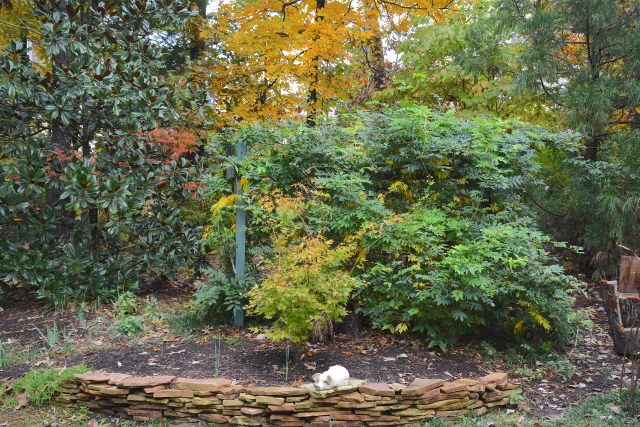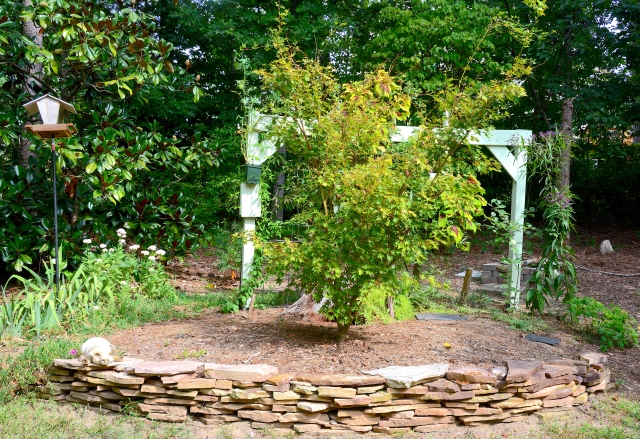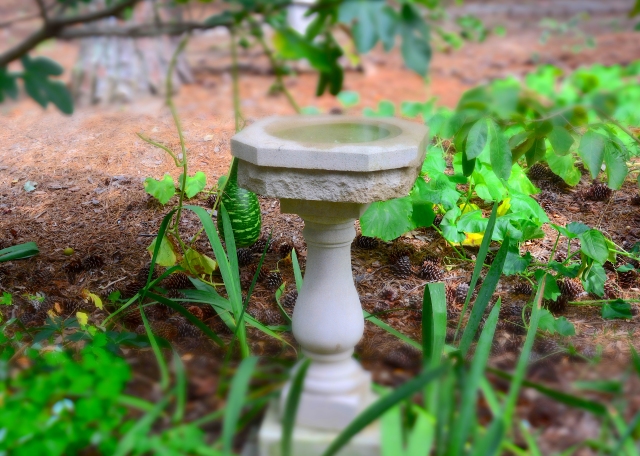by Wendy Diaz, EMGV
On July 9, 2020, the New Hope Audubon Society (NHAS) revisited my suburban yard to evaluate it after I implemented their recommendations of their initial visit two years ago. I wrote about this very interesting experience in three installments for the Durham Master Gardener Blog[i] in November 2018. I earned the “Gold” level of certification from the NHAS Bird Friendly Habitat back in August, 2018 but I did not receive the highest level of Platinum, largely because greater than 10% of my available property, which is about 13,250 sq. ft. of a total of 16,117 sq. ft., was still covered by high-threat invasive species despite already having removed some exotics. These areas were located mostly along the north side yard and east-facing back yard of my property and native plants only covered 30% of the remainder of my yard. I had to increase the native plant coverage from 30% to 50% and remove the invasive species to less than 10% in order to achieve the platinum level. This was a fair amount of work but surprisingly easy when I did it in stages over two years. This time, two representatives (Alan Johnson and Jeanne Arnts) came from the New Hope Audubon Society and walked around my yard and natural buffer area and patiently answered all my questions. Jeanne Arnts took notes and both of them pointed out species of plants that were good for the birds.
It is well documented that planting native plant species is beneficial for birds and other wildlife[ii]. Native plants, especially native trees, host a variety of insects that are necessary for birds to feed their young and these plants host the insects that are vital to birds and the complex food webs that evolved in our local area. Not only do native gardens provide food, they provide shelter and nesting sites for birds. They also have the added benefit of reducing the need of added resources such as fertilizer because they are uniquely adapted to and thrive in our local area. Even with a portion of my suburban backyard preserved as a natural area with mature hardwoods, much of my yard space had at one time, 10 of the 17 most invasive species listed as species to avoid in the Piedmont North Carolina[iii]:
- English ivy (Hedera helix),
- Privets (Ligustrum spp.),
- Autumn olive (Elaeagnus umbellate),
- Chinese wisteria (Wisteria sinensis),
- Japanese honeysuckle (Lonicera japonica),
- Mimosa (Albizia julibrissin),
- Periwinkle, Vinca (Vinca spp.),
- Bradford pear (Pyrus calleryana)
- Japanese stiltgrass (Microstegium vimineum)
- Sacred bamboo (Nandina domestica)
In addition, I unwittingly planted the non-native invasive species: Golden rain tree (Koelreuteria paniculata), burning bush (Euonymus alatus) and monkey grass (Ophiopogon japonicas) and other invasive plants just appeared in my yard without my help, like purple beautyberry (Callicarpa dichotoma) and Chinese holly (Ilex cornuta).
The 2018 visit was a custom assessment of my yard and garden with respect to native plant species and wildlife habitat and a very educational two hours. I was delighted to be informed that I had several native wildflowers growing in my natural area like the diminutive native Crane-fly orchids (Tipularia discolor; also a subject of another blog article https://durhammastergardeners.com/2020/07/) under my beech tree (Fagus grandifolia) as well as another shade-tolerant native Redring Milkweed (Asclepias variegata L.) near a very large white oak. In the natural buffer area there was one of North Carolina’s smallest woody plants, Spotted Wintergreen (Chimaphila maculate). A native ground cover of Virginia snakeroot (Aristolochia serpentaria) was also scattered throughout the leaf litter. Other native shrubs of arrowwood (Viburnum dentatum) and St. Andrew’s-cross (Hypericum hypericoides (L.) Crantz) were quite common in my backyard, not to mention a young Black gumtree (Nyssa sylvatica), which sadly succumbed to a dry spell in September, 2019 when I was out of the country.

Photo taken June 3, 2020
The Work
A few weeks after the first visit my husband and I started to tackle the invasive species removal. We waited until there was a substantial rain to loosen the soil around the plant roots. We took out the invasive species armed with hand pruners, lopper, shovel, lawnmower and chainsaw. In a matter of a few days stretched over the past two years we completed Stage 1 and 2 of the removal of invasive species. One of the advantages of pulling and rolling the periwinkle (Vinca major) after a rain to loosen the soil or just mowing was that I did not have to use an herbicide which may have harmed the soil and prevented germination of native plants which could germinate now that they were exposed to sunlight.
Clockwise from left: On November 5 and 12, 2018 Chinese wisteria (Wisteria sinensis) was removed with loppers and the trunk was cut with a chain saw. A woodpecker and robin immediately investigated the newly exposed soil. On November 3, 2018, after a good rain, the periwinkle was pulled up by the roots behind the birdbath and near the concrete bench. I found the periwinkle stems matted and could be rolled as I progressively pulled up the roots and made a ball. My husband used a chainsaw to take out the firebush on December 16, 2018. The following year on May 7, 2019 I dug out the coreopsis and monkey grass that was taking over my front perennial bed. The monkey grass roots were so tangled that I was able to remove it in one long caterpillar-like piece. On April 28, 2019, I mowed the large patch of periwinkle and Japanese honeysuckle along the north side yard with the lawn mower. My son mowed it again several months later when new shoots appeared but the second mowing along with a dry September finished it off for good except for an occasional plant that I weeded this year.











I also planted some pink and white muhly grass (Muhlenbergia capillaris) to replace the crabgrass that inevitably takes over the strip of lawn between the driveways. The last job was the removal of the forsythia hedge (bottom right corner) for a spring planting of Fothergilla bushes (purchased just before the Covid-19 lockdown) behind the birdbath in addition to a bed along the south side of the house on March 14, 2020. I did not have a chance to purchase any more native plants this year but Mother Nature helped out with the abundant rainfall this spring and many Eastern red cedars (Juniperus virginians) grew and filled in the area on the north side along with Virginia creeper (Parthenocissus quinquefolia). Plants that I purchased like Virginia sweet spire (Itea virginica), dwarf crested iris (Iris cristata) and wild ginger (Asarum canadense) became established and spread. It has been an excellent year for moss and it has spread downslope with little encouragement, from our fairy garden to our cedar bench along our property boundary. I also collected wild columbine seeds and spread them around the newly exposed areas. I did not amend the soil other than spreading leaves and pine needles, which I gathered off my fescue lawn, around my native plants.



Photo taken May 27, 2020
We managed to complete both Stage I and Stage II Removal plans as outlined in my blog article of November, 2018 without complaint but, due to Covid-19 and other extended family duties, I did not plant as many of the alternatives recommended to me by NHAS in their report from the first visit. I wasn’t having much luck sourcing some of the native ground covers I wanted to plant anyway like Frog fruit (Phylla nodiflora). I updated my plant list with the recent purchases of native plants in the fall of 2018 and spring of 2019 and 2020 (muhly grass, wild ginger, dwarf crested iris, fothergilla etc.) along with other natives pointed out to me by the Audubon Society representatives on their second visit: American pokeweed (Phytolacca americana) and American boneset (Eupatorium perfoliatum). I transplanted some blueberries from under my beech tree to the south yard. This year several plants of spotted wintergreen (Chimaphila maculate) have now appeared under my beech tree along with four more groups of cranefly orchids (Tipularia discolor). I developed a nursery of Eastern red cedar in an area mostly covered by wild columbine, which tended to have numerous red cedar seedlings anyway. I will transplant them along my southern property boundary as a privacy screen when they get a bit larger.









The Maintenance
They don’t call them invasive species for no reason and some species need constant vigiliance and weeding. It is a task that takes very little effort now that our new Covid-19 habit of walking through our yard reveals new invaders when they first appear and are easily dealt with. A new crop of mimosa seedlings sprouted up in the north side yard after the abundant August rain this year but they were easily dispatched. And it has been five years since we cut down the mimosa tree! In addition, the occasional golden raintree seedling shows up in the bed behind the birdbath. If I find myself missing the bright yellow blossoms of the golden rain tree out my bedroom window I will look at this photograph instead which is just as enjoyable but without the additional work of weeding.
Also, new alien plants appeared in the north side yard like the Chinese elm (Ulmus parvifolia), Japanese hop (humulopsis scandens) and the dayflower (Commelina communis) which were also pulled up. Photographs from left: Golden rain tree seedling, golden raintree in bloom (now removed) and mimosa seedlings in foreground next to dwarf-crested iris.



I would like to purchase some spice bush (Lindera benzoin) to fill in the areas where the forsythia hedge was removed and also to increase the midlevel landscape with shrubs in my yard and shade out the weeds. I plan on replacing the non-native morning glory at the mailbox next year with the native clematis viorna (Clematis viorna).
The Reward
I was delighted to see many native wildflowers either spread or appear for the first time without me planting them in the areas I cleared of Chinese wisteria, periwinkle and Japanese honeysuckle and observing the garden become more vibrant. I also refrained from applying a thick layer of mulch in other parts of the natural tree area this year. It is amazing what nature can do with a little less competition from invasives and a little more sunlight. And of course, it helped that my neighbors and I organized and advocated to preserve a 30-foot tree buffer between our neighborhood and the proposed new subdivision, which replaced the forest behind my house back in 2003. Photographs clockwise from left: Blue-eyed grass (Sisryrinchium angustifolium), lyreleaf sage (Salvia lyrata), spotted wintergreen (Chimaphila maculate), redring milkweed (Asclepias variegata L.), flowering spurge (Euphorbia corollata), hairy skullcap (Scutellaria elliptica), American boneset (Eupatorium perfoliatum) and wild columbine (Aquilegla canadensis).








The abundant rainfall this spring produced native plants such as Coral honeysuckle, St. Andrew’s cross, Virginia snakeroot or Dutchman’s pipe and climbing dogbane to appear in the former Chinese wisteria area of the backyard. My tulip poplar tree in the front yard also had an unusual amount of blossoms for the bees to enjoy.





One of the requirements for certification is to have eight or more wildlife habitat options from the Audubon list of 13. I managed to have the entire list: water feature/bird bath, no cats or kept indoors, several functional birdhouses, brown-headed nuthatch birdhouse (species of concern), rock piles and branch bundles, pollinator garden(s), several snags (maple, black gum, cedar and cryptomeria), window stickers to reduce collisions, leaf litter, reduced lawn areas, minimal use of nonorganic fertilizers, no usage of rodenticides and replaced 30-year-old gas lawn mower, hedge-clipper and weed-eater with battery powered tools. Thanks to my industrious neighbor and friend, Roger Fortman, who made and gave me a bird feeder and two more birdhouses, I have more than the minimum required wildlife habitat options and a very good wildlife habitat suburban garden and yard.

If You Plant It They Will Come
My yard now has 73 native plant species including canopy and understory trees, shrubs, herbaceous plants and vines which flower at different times throughout most of the year. I also have large areas with leaf litter in my yard and a few trimmed dead trees left standing (snags). As the native plants have spread and established themselves, I have observed more caterpillars, butterflies, bees, fireflies and birds as well as lizards, toads and frogs. Photographs clockwise from left: Eastern tiger swallowtail and monarch butterfly on common milkweed (Asclepia syriaca), bumble bee and common buckeye butterfly on butterfly weed (Asclepia tuberose) and Eastern tiger swallowtail on Beautyberry (Callicarpa americana) and scarlet rose mallow (Hibiscus coccinneus).
Photographs from left: Bumble bee on purple passionflower (Passiflora incarnata) and dragonfly on dead milkweed leaf.


Many birds have been observed in the yard this year. Photographs clockwise from left: Female Red-bellied woodpecker and fledgling, bluebird, juvenile Ruby-throated hummingbird, goldfinch, White-breasted nuthatch, male bluebird with beetle and Red-tailed hawks.







Learning about many new native plants since that first NHAS visit in 2018 has been interesting and I found the follow-up visit rewarding and well worth the effort. I do not have any regrets about removing all invasive ornamental plants from my yard as it has given me the opportunity to learn and discover new native alternatives to plant and a chance to welcome nature’s gifts each spring. My yard is much more interesting and entertaining as well because there is a large variety of plants which flower throughout most of the year and wildlife to watch. This transformation to a yard where I can enjoy nature couldn’t have happened at a better time. All the work was worth it and I achieved the highest level of certification.
While I have achieved my goal of Platinum certification, my gardening work is never done and the plan is to remove the severely pruned Burford holly (Ilex cornuta ‘Burford’) foundation hedge at the front of the house. Alan Johnson suggested native alternatives such as dwarf yaupon holly (Illex glabra) or sweet pepper bush (Clethra anifolia) to replace the old hedge. He said the ‘Hummingbird’ cultivar produces numerous flowers and good fall color. To compliment these new shrubs other sun-loving herbaceous perennials such as golden alexander (Zizia), mountain mint (Pycnanthemum mutium) and aster (Symphyotrichum spp.) were suggested. There are many other natives to choose from but they reminded me that it is very important to choose native plants that were grown without the use of neonicotinoids and they provided source nursery’s that did not use this systemic insecticide in their four page report which they emailed to me shortly after their visit.

Photo taken September 10, 2020
I proudly hang the Audubon sign on my mailbox for passersby to see and hopefully it will encourage at least one neighbor to undertake this certification process and rewarding experience. I want to inspire like-minded gardeners to contact the New Hope Audubon Society for their own certification so they too can sit back and enjoy the birds they will attract. I am looking forward to next spring and to observing how the garden has matured and perhaps I will see the spotted wintergreen finally flower or a brown-headed nuthatch take up residence in its waiting home. In the meantime, I will buy a frame for my Platinum Certificate from the New Hope Audubon Society.


References:
[i] https://durhammastergardeners.com/2018/11/ November 7, 2020; November 10, 2020 and November 21, 2020
[ii] http://www.bringingnaturehome.net
[iii] https://nc.audubon.org/sites/default/files/piedmont_plants_final.pdf
Resources for Bird Friendly Habitat Certification:
Certification Request Form:
Brochure: http://www.newhopeaudubon.org/wpcontent/themes/nhas/library/docs/certificationBrochure.pdf
Native Plant List and Suppliers:
Bird Friendly Habitat Information:
700 Bird-Friendly Native Plants for North Carolina
Further Reading:
- http://ncbg.unc.edu/uploads/files/ControllingBooklet.pdf
- https://projects.ncsu.edu/goingnative/howto/mapping/invexse/index.html
- http://www.ncwildflower.org/plant_galleries/invasives_list
- http://moinvasives.org/wpcontent/uploads/2016/03/MNRC_EmergingInvasives_QuinnLong_2016_0203_NotesPage.pdf
Article Short Link: https://wp.me/p2nIr1-1MK





